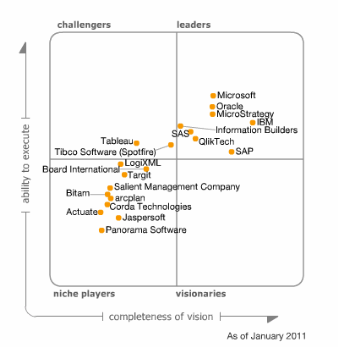Gartner Magic Quadrant for Business Intelligence Platforms- Microsoft is the leader
Microsoft: Strengths
“Microsoft has been steadily gaining BI market share since its serious entry into the market in 2000. It did so with an attractive set of BI capabilities, packaging and pricing that appeal to Microsoft developers and its independent distributor channel. The company has consistently invested in building and enhancing BI capabilities into three of its core offerings — Microsoft Office, Microsoft SQL Server and Microsoft SharePoint — in order to increase their value and drive upgrades. By incorporating BI capabilities into Microsoft's most ubiquitous products, it virtually guarantees its BI offering's continued adoption, particularly in organizations with a Microsoft-centric information infrastructure. Based on the Magic Quadrant customer survey, Microsoft is executing well on this strategy, with customers rating it above average across many key satisfaction metrics, including "sales and customer experience" (including product quality and support), "achievement of business benefits," as well as for "vendor success." Strong customer satisfaction with its approach is reflected in Microsoft's Ability to Execute position.
Microsoft's low license cost bundling strategy for BI platforms make it a compelling cost value proposition for organizations that want to deploy BI to a wider range of users, or that want to lower overall BI portfolio costs by using lower-cost BI tools for basic BI functions. Its license cost profile is comparable to or less than open source BI vendors and considerably less than its commercial competitors. And as Microsoft continues to enhance its BI capabilities in products that most companies already own (Office, SQL Server and SharePoint), the functionality premium for alternatives may become increasingly difficult to justify for many organizations. In the Magic Quadrant customer survey, more Microsoft customers cited TCO as the No. 1 reason for selecting Microsoft as a BI vendor, while cost was cited less frequently as a limitation to wider deployment for Microsoft than most other vendors in the survey.
Microsoft's market success is also driven in part by its IT-oriented, BI authoring tools within SQL Server, which are based on Visual Studio, the broadly adopted development environment. This approach, along with targeted marketing efforts and programs for building strong developer communities and support, has helped Microsoft lower the cost and expand the availability of Microsoft BI skills. Microsoft customers rate its BI platform infrastructure and development tools among the highest compared to other vendors, and a higher percentage of customers use them extensively. Moreover, "wide availability of skills" is among the top reasons customers select Microsoft over competing vendors.
Success in larger deployments is also a strength. While Microsoft's BI products have historically been labeled as midmarket solutions — particularly by Microsoft's competitors — we are seeing the Microsoft BI platform deployed on much larger data volumes to much larger numbers of users, with more of its customers considering it their BI platform standard than in previous years. Customers in the Magic Quadrant survey report that their Microsoft average deployment sizes are now larger than any other vendor in the survey in terms of users, and second only to MicroStrategy based on data volume.
Use of OLAP functionality by Microsoft customers is more than double that for the rest of the survey respondents. This can be attributed to the success and adoption of Microsoft SQL Server Analysis Services functionality bundled with Microsoft SQL Server and its optimizations with Microsoft front-end tools. Increasingly, organizations are turning to newer in-memory OLAP architectures over traditional multidimensional OLAP architectures to support dynamic and interactive analysis of large datasets. Microsoft has put an initial "stake in the in-memory ground" (albeit late) with the introduction this year of SQL Server PowerPivot, and has previewed fully in-memory Microsoft Analysis Services cubes that enable the subsecond analysis of billions of rows (as opposed to hundreds of millions of rows supported today by PowerPivot) — these will be available in the next release of SQL Server, code named Denali.
Microsoft is the only BI platform vendor to tie its BI strategy tightly to its enterprise collaboration platform, SharePoint, which is the mechanism by which Microsoft BI content is managed, searched and shared throughout the organization. Microsoft's BI customers have a very positive view of its collaboration-centric approach to BI. SharePoint 2010's new features, such as enhanced search and social software capabilities, open up new opportunities for Microsoft and its partners to evolve SharePoint into a decision making platform for improving the quality and transparency of collaborative decisions.”
You can access the full report here
For more information please read the following post: Microsoft recognized by Gartner as a Leader in Business Intelligence based on “Ability to Execute” and “Completion of Vision”
